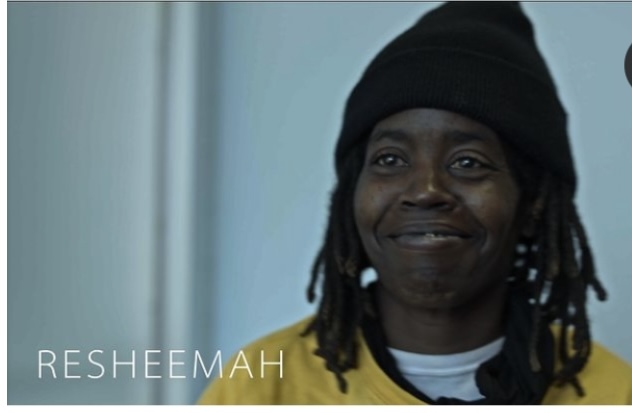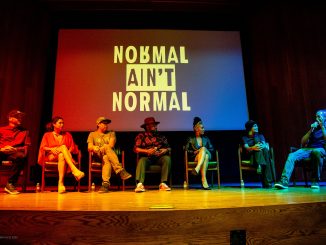
On the opening of his vignette, James “DJ Nyce” Goodwin looks into his cellphone camera resting on the Volkwagen bug’s dashboard that he lives in and bluntly declares that he is homeless. He then explains his frustration with being unhoused because he’s a man with many dreams, but also can’t recall when was the last time he slept in a bed. He then asks the viewer to pray for him.
The dream of escaping their unhoused situation in the Bay Area while spotlighting the complex, and often bureaucratic, reasons why it’s not as easy as it seems is the running theme in We R Here, a documentary by Oakland-based director Kyung Lee.
The film is credited with four co-directors: Lee, Goodwin, William “Billy” Pearce, and Maria Fuentes. The film is primarily comprised of footage that three houseless people–co-directors Goodwin, Pearce, and Fuentes–document on cell phones.
Co-director Lee, whose previous documentary work includes TELOS: The Fantastic World of Eugene Tssui, said that another project she was working on, about displaced working class people, led her to this idea. She found a group of artists in Oakland who were in a warehouse in West Oakland that had been deemed unfit for living in, leading to the residents becoming displaced and houseless.

Through this, she was surprised to find such a strong sense of community that exists in homeless encampments. “This is something people don’t know and I wanted to capture it in the film,” Lee said.
Lee’s vision was to create a film that highlighted the real lives of those who were unhoused, beyond the stereotypes.
“The approach I took in this film is to illustrate both the uniqueness of each character and the parallel circumstances they similarly experience due to their poverty,” Lee told Oakland Voices.
Lee met William Pearce, Jennifer Pearce, and Maria Fuentes and Juan Hachomorales in late 2019, right before COVID. The pandemic caused major delays for the film. She later met Goodwin in 2021. “We tried about six or seven people who showed an interest in filming their lives,” when asked why she chose these three people to film. “We ended up with the three characters in the film who were able to make a commitment to film themselves for a long period of time.”
“As I interacted with the characters and got to know them, I realized that each person’s specific circumstances that led to them becoming unhoused is unique and multi-layered,” Lee continued. “At the same time, one common theme I encountered is a perpetual punishment inflicted on the poor in our society.”
From a mock cheer after getting one dollar after two hours of panhandling to getting excited at watching two teens doing bicycle tricks, the documentary shows humane glimpses into the daily, monotonous life of the people living in the broken down RVs and sidewalk tents that have become a common sight in most Bay Area cities.
One of the strongest myths the documentary dispels is the notion that being “unhoused” implies living a solitude lifestyle. As these three vignettes show, there is a lot of family and community help that goes into their basic survival.
Goodwin has an aunt that lets him shower at her apartment and his mother regularly calls him to bring him dinner. The Pearces, who are featured in the second vignette, have each other. While panhandling with Billy Pearce’s friend David “Hillbill” Collins, they get support from strangers offering bags of Tostitos and prayers. The Pearces’ RV is then destroyed and their 17 dogs are taken by the police after the police get a court order to investigate their RV. Collins then offers his tent to the Pearces and all three sleep on the concrete floor of a freeway overpass in Emeryville, until the Pearces decide to try their luck in San Francisco.
But the vignette with Fuentes and her boyfriend Hachomorales shows the promise and frustration with the City of Oakland’s bureaucracy in their attempts to help the large homeless encampment along High Street and 880 freeway. The documentary shows City of Oakland crews cleaning up trash around the encampment, but they give Maria the runaround when she simply asks who she can get some garbage bags from.
This story also shows the promise and frustration Fuentes feels with the community at the encampment as well. She shows the great job Hachomorales has done at planting discarded flowers and plants he recovers from the Home Depot across the street as he tries to beautify the neighborhood in attempts to keep people from littering there. But we also see limited help from the other encampment members when it’s time to clean up the trash within the encampment, or to even to move some of their vehicles so the City can pick up a mound of garbage on the site.
There is a scene where the City of Oakland employees, along with City Councilmember Noel Gallo, talk to the encampment members about their plans to remove them from that city land and to other plots. Maria questions why they weren’t consulted and the finger pointing between city officials instantly begins.The documentary also shows the Sisiphian task of cleaning up the encampments when just as city workers are done removing non-working RVs; shortly after, Fuentes points out the new ones that begin to arrive.
The documentary with all three vignettes premiered at the New Parkway Theatre on October 25th. Lee is actively looking for future venues, both physical and virtual, to screen and distribute the film moving forward.
“My goal as a filmmaker is to create an atmosphere and a lingering impression where audiences are left to wonder and to reflect further,” Lee said. “I am aware that many people have strong feelings about people living on the streets. I hope that by watching this film they can look beyond their preconceived ideas.”
+ + +
For more information, visit the documentary’s website, WeRHereFilm.com.
Eduardo Jimenez knew at an early age that growing up in Oakland was going to be a special experience. He would pass the Oakland Hells Angels headquarters as well as “Free Huey” spray painted signs on the way to his elementary school where his mom fought to establish bilingual education in the early '80s.
He learned at an early age to appreciate his hometown for truly being an international city with classmates and neighbors from across the world. He knows the immigrants and long time residents that make up Oakland’s population have a personal story worth telling that will show us that we’re all on the same journey, if you dig deep enough.
He is a husband and a father of two young boys and a graduate of the Fremont High School Media. Go Tigers.




Be the first to comment